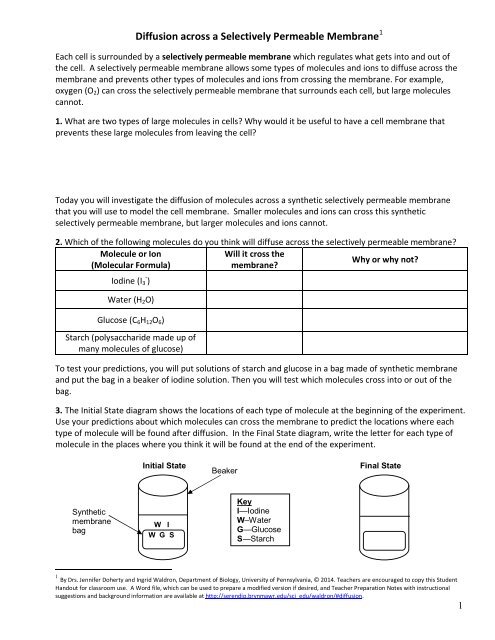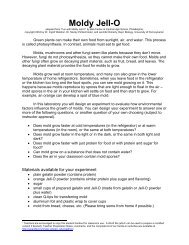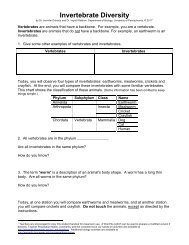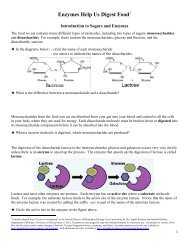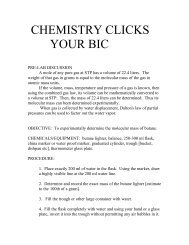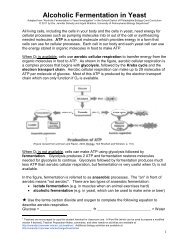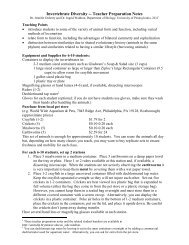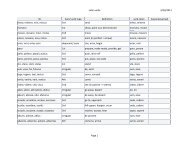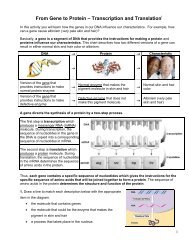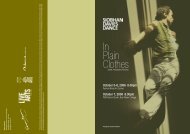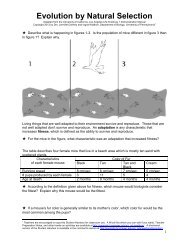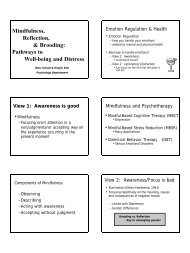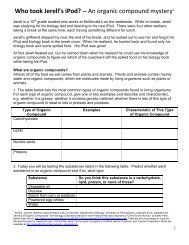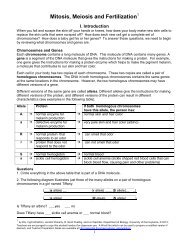Diffusion across a Selectively Permeable Membrane - Serendip
Diffusion across a Selectively Permeable Membrane - Serendip
Diffusion across a Selectively Permeable Membrane - Serendip
Create successful ePaper yourself
Turn your PDF publications into a flip-book with our unique Google optimized e-Paper software.
<strong>Diffusion</strong> <strong>across</strong> a <strong>Selectively</strong> <strong>Permeable</strong> <strong>Membrane</strong> 1<br />
Each cell is surrounded by a selectively permeable membrane which regulates what gets into and out of<br />
the cell. A selectively permeable membrane allows some types of molecules and ions to diffuse <strong>across</strong> the<br />
membrane and prevents other types of molecules and ions from crossing the membrane. For example,<br />
oxygen (O 2 ) can cross the selectively permeable membrane that surrounds each cell, but large molecules<br />
cannot.<br />
1. What are two types of large molecules in cells Why would it be useful to have a cell membrane that<br />
prevents these large molecules from leaving the cell<br />
Today you will investigate the diffusion of molecules <strong>across</strong> a synthetic selectively permeable membrane<br />
that you will use to model the cell membrane. Smaller molecules and ions can cross this synthetic<br />
selectively permeable membrane, but larger molecules and ions cannot.<br />
2. Which of the following molecules do you think will diffuse <strong>across</strong> the selectively permeable membrane<br />
Molecule or Ion<br />
Will it cross the<br />
Why or why not<br />
(Molecular Formula)<br />
membrane<br />
Iodine (I 3 - )<br />
Water (H 2 O)<br />
Glucose (C 6 H 12 O 6 )<br />
Starch (polysaccharide made up of<br />
many molecules of glucose)<br />
To test your predictions, you will put solutions of starch and glucose in a bag made of synthetic membrane<br />
and put the bag in a beaker of iodine solution. Then you will test which molecules cross into or out of the<br />
bag.<br />
3. The Initial State diagram shows the locations of each type of molecule at the beginning of the experiment.<br />
Use your predictions about which molecules can cross the membrane to predict the locations where each<br />
type of molecule will be found after diffusion. In the Final State diagram, write the letter for each type of<br />
molecule in the places where you think it will be found at the end of the experiment.<br />
Initial State<br />
Beaker<br />
Final State<br />
Synthetic<br />
membrane<br />
bag<br />
W I<br />
W G S<br />
Key<br />
I—Iodine<br />
W–Water<br />
G—Glucose<br />
S—Starch<br />
1 By Drs. Jennifer Doherty and Ingrid Waldron, Department of Biology, University of Pennsylvania, © 2014. Teachers are encouraged to copy this Student<br />
Handout for classroom use. A Word file, which can be used to prepare a modified version if desired, and Teacher Preparation Notes with instructional<br />
suggestions and background information are available at http://serendip.brynmawr.edu/sci_edu/waldron/#diffusion.<br />
1
You will use color change to test whether starch and iodine have crossed the synthetic membrane. A<br />
solution of iodine is tan and a solution of starch is clear or milky white; when iodine and starch are together<br />
in the same solution, the solution is dark blue or black. To test whether glucose crossed the synthetic<br />
membrane, you will use a glucose test strip to test for glucose in the solution in the beaker. If water can<br />
cross the synthetic selectively permeable membrane, water could diffuse into the bag or out of the bag.<br />
Your teacher will let you know how you will test for change in volume of water in the bag.<br />
4. For each substance, indicate how you will know whether it crossed the synthetic membrane. What<br />
observation will be different, depending on whether or not this substance crossed the synthetic membrane<br />
Expected Observations<br />
Substance<br />
If this substance crossed the membrane If this substance did not cross the membrane<br />
Starch<br />
Iodine<br />
Glucose<br />
Water<br />
Procedure:<br />
Obtain a piece of pre-soaked dialysis tubing and two pieces of string. Fold the bottom of the piece of<br />
tubing 1 cm up and use a piece of string to tie the folded part tightly to create a bag.<br />
To open the other end of the tube, rub the end between your fingers until the edges separate. Use<br />
pipettes to add 4 mL of glucose solution and 4 mL of starch solution to the tube.<br />
After the tube is filled, fold 1 cm of tubing at the top of the bag and tie it off tightly. Check to make sure<br />
there are no leaks. If scissors are available, trim the strings short.<br />
Rinse the bag and strings thoroughly in fresh water. Dry the bag and strings thoroughly.<br />
In the table below record your initial observation of the measure you are using to evaluate the<br />
movement of water.<br />
Add 200 mL of distilled water to a 250 mL beaker. Add about 0.8 mL iodine to the water in the beaker.<br />
Caution: Be careful to avoid staining your clothes or fingers with the iodine.<br />
Put the bag in the beaker.<br />
5. Record your observations of the colors of the solution in the bag and the solution in the beaker in the<br />
“Initial State” row in the table below.<br />
In the bag In the beaker Measure to evaluate<br />
Color Glucose Color Glucose movement of water<br />
Initial State Yes No<br />
Final State<br />
Yes<br />
You will need to wait 20-30 minutes for substances to move <strong>across</strong> the selectively permeable membrane.<br />
While you're waiting, answer the <strong>Diffusion</strong> and Osmosis Questions on pages 4-5.<br />
After 20-30 minutes, record your observations in the “Final State” row of the table.<br />
2
6. Did iodine cross the membrane How do you know<br />
7. Did starch cross the membrane How do you know<br />
8. Did glucose cross the membrane How do you know<br />
9a. There was water on both sides of the membrane, in the bag and in the beaker. Did water cross the<br />
membrane Did more water move into the bag or out of the bag How do you know<br />
9b. Was this result the same as or different from your prediction in question 16<br />
10. Complete the following table to compare your observations with your predictions on page 1.<br />
Molecule or Ion<br />
Does it cross the membrane<br />
(Molecular Formula)<br />
Prediction<br />
Observation<br />
Iodine (I 3 - )<br />
Water (H 2 O)<br />
Glucose (C 6 H 12 O 6 )<br />
Starch (polysaccharide made up of<br />
many molecules of glucose)<br />
11. What do you think is the explanation for any differences between your predictions and your<br />
observations<br />
12. Based on your results, what characteristic appears to determine which molecules and ions can cross the<br />
synthetic selectively permeable membrane<br />
3
A model is a simplified representation of a complex biological structure or process. A model focuses on a<br />
few key features in order to help us understand a biological structure. Because a model is simpler than the<br />
biological structure it represents, a model does not demonstrate all the features of the actual biological<br />
structure.<br />
You have already analyzed one model of the selectively permeable cell membrane – the synthetic<br />
membrane in your experiment. This diagram provides a different model of the selectively permeable cell<br />
membrane; it shows the molecules in a cell membrane, including several of the proteins that aid in the<br />
transport of biologically important ions and molecules <strong>across</strong> the cell membrane.<br />
Fluid outside<br />
the cell<br />
The relative concentrations of molecules or ions on either side of the cell membrane are indicated by<br />
the size of the print. Cells make ATP which provides the energy for cellular processes like pumping Na+<br />
and K+ <strong>across</strong> the cell membrane. (http://hyperphysics.phy-astr.gsu.edu/hbase/biology/imgbio/lipbitran.gif)<br />
Cell membrane<br />
has proteins and<br />
double layer of<br />
phospholipids.<br />
Watery cytosol<br />
inside the cell<br />
Both models (this diagram of the cell membrane and the synthetic membrane in your experiment) show<br />
that small molecules and ions can cross the selectively permeable membrane. However, there are some<br />
differences in other features of these two models.<br />
13a. The fourth type of transport shown in the diagram is observed in living cells, but not in a synthetic<br />
membrane. Explain why this type of transport is possible in living cells, but not in a synthetic membrane.<br />
13b. Which feature of cell membranes was demonstrated by your experiment with the synthetic<br />
membrane, but is not shown in the diagram (Hint: Think about starch.)<br />
<strong>Diffusion</strong> and Osmosis Questions<br />
14a. During diffusion, more molecules will move<br />
a. from areas of high concentration to areas of<br />
low concentration<br />
b. from areas of low concentration to areas of<br />
high concentration<br />
14b. The reason is that:<br />
a. Crowded molecules want to move to an area with more room<br />
b. Molecules tend to keep moving until they are uniformly distributed and then they stop moving.<br />
c. The random motion of molecules results in their uniform distribution in the available space.<br />
Osmosis is the diffusion of water <strong>across</strong> a selectively permeable membrane.<br />
4
Na+, Cl-, and the water molecules that are bound to these<br />
ions cannot cross this selectively permeable membrane<br />
(called a semipermeable membrane in this figure). Only<br />
free water molecules can cross the selectively permeable<br />
membrane.<br />
During osmosis, diffusion results in movement of free water<br />
molecules in both directions <strong>across</strong> the selectively<br />
permeable membrane, but more free water molecules<br />
move from the region of higher concentration of free water<br />
molecules to the region of lower concentration.<br />
15. Explain why the concentration of free water molecules<br />
is higher in pure water than in water with dissolved salt.<br />
16. Why is water moving from the side of the tube that has pure water to the side of the tube that has<br />
water with dissolved salt Include in your explanation the relative concentrations of free water molecules<br />
on the two sides of the tube.<br />
17. In your experiment, the concentration of dissolved substances is higher in the starch and glucose<br />
solution in the bag than in the iodine solution in the beaker. Which way would you expect more water to<br />
diffuse – into the bag or out of the bag Explain your reasoning. Include in your explanation the relative<br />
concentrations of free water molecules inside and outside the bag.<br />
W I<br />
W G S<br />
5


